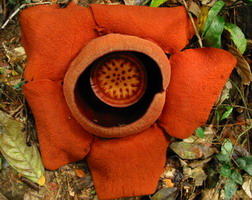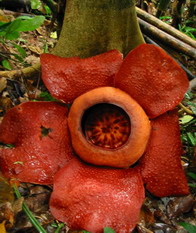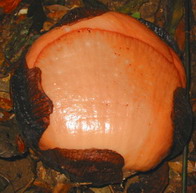|
Welcome To
RAFFLESIA
FLOWER,
BORNEO PAGE
|
Rafflesia- The Worlds Largest
Flower

History
There is even more to tell of its ‘discovery’ and its claim
to fame as the largest flower on earth. In the year
1818, Sir Stamford Raffles was posted as Governor to
Bencoolen in Sumatra which was then, the
administrative centre for the British East India
Company for Western Sumatra. Raffles’s interest in
natural sciences was insatiable.
A respected and popular member of the Royal Society in
London, Raffles arranged and persuaded a fellow
society member - Dr.Joseph Arnold to accompany him
on an expedition into the interiors of Sumatra. It
was on one of these expeditions that they stumbled
on a discovery which was to puzzle botanists for a
long time. Unfortunately, Dr Arnold died because of
jungle fever before presenting the report to the
society.
Habitat
Rafflesia are endemic to Southeast Asia recorded 17 known
species, the Rafflesia flowers have been found only
in Indonesia - Sumatra and Java, Malaysia, including
Borneo island and south Thailand. Rafflesias have
small, brownish, scale like leaves and fleshy,
foul-smelling flowers of various sizes from few
inches to meter big in diameter. Rafflesia
classified as parasite, which means it just takes
the nutrient out of its host.
The Rafflesia can be found at altitudes of between 500 and
700 meters in the forests of Malaysia, Southern
Thailand, Sumatra and Java in Indonesia. In these
tropical rainforests, the climate is continuously
warm and humid, with very high humidity. The
Rafflesia is rare and fairly hard to locate. It is
especially difficult to see in bloom; the buds take
up to 10 months to develop and the blossom lasts for
just a few days. However, how many these strange
plants are survived in primary rainforest is still
unknown.

Characteristic
The cabbages like bugs that produce before blooming are size
of cabbage. The large fleshy flower is what we
usually notice; this is the flower’s sexual organ.
There is a deep well in the centre of the flower
containing a central raised disc that supports many
vertical spines. The sexual organs are located
beneath the rim of the disk, and male and female
flowers are separate.

The reddish brown colors of the petals, sprinkled with white
freckles exudes act most unpleasant stench, similar
to rotting flesh or carrion. Some people believe
that the stench attracts flies and insects which
help disperse the seeds. Others believe that large
animals could be agents for this seed dispersal. In
order for the seed to germinate, it was found that
the vine of the host plant must be damaged in some
way so that the filaments of the seed may infiltrate
successfully. The damage to the host vines could be
made by trampling hoofs of large animals. The seeds
adhere to the passing animals’ hoofs and are
transported to other places where they can find host
plants to attach to.

News Corner - The Star, Malaysia
Date: Wednesday September 20, 2006
Rafflesia Found Beside Highway
By RASLAN BAHAROM
GERIK: Droves of people have been drawn to a rubber estate
located beside the East-West Highway to get a close look at a
Rafflesia Azlanii plant in full bloom.
The crowd gathered at a Felda-owned rubber-replanting scheme at
Bersia, about 20km from here, are mainly academicians,
undergraduates, forestry officers and nature lovers, including
foreign tourists.
“Previously, nature lovers had to spend hours hiking or be
ferried by boats deep into the Belum forest to see such a plant.
Now they need only spend about 30 minutes of their precious time
to experience a wonder of nature growing just beside the
highway,” said Ishak Yahaya, 35, who has assumed the role of
tour guide at the site.
“I was jobless previously but now I am looking after these
beautiful flower,” said Ishak who is from the nearby Kampung
Bogor.
Ishak said with the help of a professor from a local university
who often frequented the site with his students, an appeal
letter was recently sent to the Land Development Authority to
preserve the location where at least nine clusters, most of the
Rafflesia Azlanii and Rafflesia Cantleyi species are found
growing in an area of about 5ha.
Ishak said what he feared most now was that some people might
harvest them as the dried petals of the flower had traditionally
been used for post-natal medication. He added that he had
accidentally stumbled on the rafflesia while searching for
herbs, a common economic activity among villagers in the Hulu
Perak district. Hulu Perak district officer Abdul Karim Osman
said he visited the site yesterday and was impressed with the
discovery.
“It will be a good tourism product for this district,” he said,
adding that an information kiosk would be set up at the
highway’s rest and recreation area. He would also discuss the
preservation of the site with Felda. According to records, the
Rafflesia Azlanii was named after the Sultan of Perak Sultan
Azlan Shah in 2003 following an expedition to the Royal Belum
forest reserve by a 106-member scientific expedition led by Prof
Dr Abdul Latif Mohamad.
The Rafflesia Azlanii, which measures 43cm in diameter, was
first discover in Sungai Halong in Belum during an earlier
expedition in 1993. Prior to its discovery, there were seven
species of the rafflesia of which three, namely Rafflesia
Cantleyi, Rafflesia Kerrii and RafflesiaHasseltii are found in
Perak.
RAFFLESIA
TOUR ENQUIRY >>
There are DAY TOUR
depart from Kuching (Gunung Gading National Park) and Tambunan
Rafflesia Center(Kota KInabalu).
|